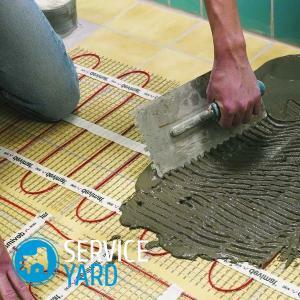
- What should I look for when choosing a warm floor?
- Classification of a warm floor
- How to install a warm floor?
Nowadays, many people who make repairs in an apartment when choosing a floor covering prefer a tile, because it looks very impressive, is practical and durable. The most important thing is its high level of heat conductivity. Therefore, if you decide to make a warm floor, then this is the ideal basis for it. In summer it will be pleasant enough to walk on a cool tile, and in the winter it will be very warm, creating a comfortable atmosphere in the house. And in this matter the main thing is to understand how to choose a warm floor under the tile, and not vice versa. There are several kinds of heating systems for the sexes, and we will discuss them in detail in this article.
to the contents ↑What to look for when choosing a warm floor?
There are several factors that must be taken into account before choosing a warm floor under the tile and installing it in your home. We will become acquainted with the criteria for choosing what to look for.
Primary or additional heat source
Typically, this heating option is used as an auxiliary and allows additional heating of the room. Perhaps you want to use the warm floor as the main heating in the winter time - then it's better to pay attention to the liquid floor.
Important! It is heated by the circulation of mineral oil or water in the pipeline, located directly under the floor.
Operating time in continuous mode
The fact is that the auxiliary systems can be used in the same way as the liquid floor, in different ways. When the duration of the continuous operation of the warm floor comes to the forefront, it is necessary to pay attention to the energy saving level.
Energy equipment of the house
Before choosing a warm floor for tiles, you need to decide what energy resources you will use for heating. In multi-apartment buildings, it is not necessary to choose especially, because the only source of energy is the electric grid. But in a private house you can power the floor from an autonomous power generator.
Type of premises
The warm floors that are used for kitchens, rooms, balconies or balconies have their own characteristics. Here everything depends on the complexity of the layout and the squares of the rooms.
Localization of
The floor can be warm not only in the whole room, but also in a certain part of it, and this must also be taken into account.
Type of coating
That is, it can be mounted under the laminate, linoleum and tiles. If the coatings in different rooms will differ, you may have to buy different systems of the warm floor. And this will affect both cash costs and the time frame for completing repairs.
to the contents ↑Classification of the warm floor
To determine the choice, it is necessary to understand the available assortment of floors presented by current manufacturers. The following options are available:
- Electrical.
- Water.
- Infrared.
Important! The tile can be laid on any kind of floor, because for insulation it is necessary to simply decompose the heating elements in those parts of the room where there will not be furniture or household appliances.
And now about each option in more detail.
Electrical floor
So, what are the properties of this heating option and how to choose a warm electric floor for the tile? It is very important to determine for the beginning the thickness of the screed, which will cover the heating system from above.
Important! The fact is that this type of floor heating is a heating cable, which can be laid as you like, for example, with a spiral or zigzag.
You can buy and ready-made mats, with the cable already fixed with a grid. And this option is ideal for a thin screed. The floor of such a variety will be fed from the mains.
Important! Advantages of electric floor:
- You can install it under any cover, whether it's tile, laminate or linoleum.
- Occupies a minimum of space.
- The heating level can be adjusted with a heat sensor.

Water Heated Floor This heating system is considered to be the simplest, since it works on the basis of using a special liquid heated to the desired temperature, which circulates through the water pipe system hidden inside the floor.
This system is connected to an autonomous gas boiler or central heating system. It looks like a set of metal-plastic or polyethylene tubules.
Important! Advantages of the water heating system:
- Versatility. After all, it is suitable for any version of the cladding. First, a screed is made, where the tubes are hiding.
- Availability. It is worth such a floor is relatively inexpensive, and, by the way, you can install it yourself.
- Low installation complexity. Anyone who does not have special skills will be able to connect such flexible pipes.
However, we must remember that creating a warm water floor in an apartment of a high-rise building will not be easy, and sometimes it is impossible from a technical point of view. Yes, and for this you will first have to go through many instances to obtain permits and create a project.
Infrared floor
If you are thinking about what kind of floor to choose under the tile in the bathroom, then the ideal option will be just such a heating system. Under any kind of tile, the rod infra-red floor perfectly suits, as it guarantees the provision of a high level of heat in the house.
It feeds on the same principle as the electric floor, but it heats up completely differently. The main for its work are carbon rods, connected to each other already at the work site or sold as ready-made solid mats.
Important! The main features of such a floor:
- Minimal energy costs.
- High level of energy efficiency.
- Ease of installation.
- Possibility to adjust the heating level.
- Heating occurs in the specified direction.
- Useful effect of radiation for health improvement purposes.
There is another version of the infrared floor, namely film, which is easier to install due to the use of heating film. He is preferred in cases where it is impossible to make a thick screed:
- The basis is taken by the heat-reflecting substrate on which the roll is stretched with heating strips and the tiles are laid on top.
- In addition, a sheet of gypsum fiber material is used, with the overlap being overlapped in order to conveniently connect the lengths of the heating elements and provide power.
How to install a warm floor?
We already know how to choose a warm floor under the tile, and now it's time to understand the features of its installation. So that you do not have problems when laying a warm floor, it is recommended to give preference to heating mats. In fact, this is the same as the heating cable, they differ only in the convenience of installation.
Important! Mats must be laid directly in the glue for the tiles, and the mesh attached cable in this case performs the role of reinforcement.
Let's look at the basic stages of laying a warm floor using the example of using mats as heating elements:
- At the first stage, we draw a diagram of the location of the heating system. On it we mark the location of large machinery and furniture, because in these points the system is not laid. Also determine the places where the thermostat and the temperature sensor will be installed.
- In the second stage, special holes are cut in the floor and wall with a width and depth of two to two centimeters, respectively. A special tube with a temperature sensor cable and a connecting cable are laid in it.
- In the third stage, the floor is leveled. It is very important to make sure that the floor is perfectly flat, otherwise - during operation, there may be problems with the operation of the heating system.
- In the fourth stage, set the temperature sensor. To do this, it is necessary to extend the sensor cable into a special corrugated tube, install a plug on it and lay it in the previously made hole. The sensor is placed between two nearby cable turns.
- The fifth stage involves laying the heating mat. During the execution of this work, it must be ensured that the cable turns do not intersect with each other.
- The sixth stage involves the installation of the system. To prevent the mats from moving during tile laying, it is recommended to glue the reinforcing mesh to the concrete floor.
- In the seventh stage we test the installed system.
- The eighth stage is the covering of mats with special glue for tiles. And, to cover them it is necessary completely all surface of mats that the system became more rigid.
- The ninth step is the re-testing of the system.
- At the tenth stage we lay the tile and connect the warm floor to electricity.
Having studied the basic selection criteria and recommendations on the laying technology, you can quickly determine which hot floor to choose for the tiles in the bathroom, kitchen or room. Thanks to the installation of such a system, you will live in the most comfortable conditions at any time of the year.



